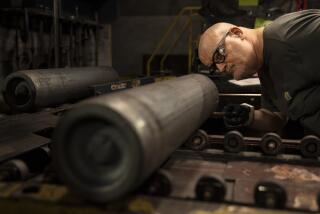Report Card on Recovery Shows Uneven Impact : Economy: Some industries are showing encouraging signs. But others could take years to turn around.
WASHINGTON — The economy is beginning to show some early signs of recovery, but the bounceback is likely to be slow and unevenly spread among key industries, economists and business analysts say.
So far, the evidence has been limited to a smattering of economic indicators: There’s been a modest upturn in the housing market. New claims for unemployment benefits have declined for two weeks in a row. Semiconductor sales have jumped. And consumer confidence is on the rise.
Wall Street appears to share that sense of optimism: The Dow Jones industrial average closed above the landmark 3,000-point level last Wednesday for the first time in history. And with interest rates and oil prices slow, economists too are more upbeat every day.
“I think the recovery is about to begin, and when we look back, we will see that this was one of the mildest recessions we have had,” says Priscilla Trumball, an economist with the WEFA Group, an economic consulting firm in Bala Cynwyd, Pa.
But analysts caution that the rebound is likely to be anemic, and visible at first in only a handful of industries--mainly those that traditionally respond quickly to lower interest rates.
“The classic pattern is for industries that are sensitive to interest rates to rebound first, and we are all hoping that pattern holds true this time,” Trumball says. “So we think that housing has already hit bottom . . . and that auto sales should start to pick up too.”
Besides housing and autos, the list of likely early winners includes computers and big-ticket consumer goods such as refrigerators and appliances. But others--such as commercial real estate, construction and industrial equipment and machinery--are likely to lag.
The trouble is that this recession has been so unlike earlier slumps that economists are unsure quite what to make of the coming recovery, and so they aren’t making their predictions with any great conviction.
“Right now, it is all a hope and a prayer,” says John Jacobson, an economist with Philadelphia-based AUS Consultants who is forecasting a recovery in the steel industry sometime this year.
So far, economists admit that there is little evidence to support their forecasts. U.S. manufacturing still is weak. Industrial production fell again in March, and American factories were operating at their lowest rates of capacity in nearly five years.
In addition, most economists expect the recovery to be a quiet one, with output growing only slightly during the second and third quarters, following declines in late 1990 and early 1991.
Just the same, Walter Joelson, chief economist at General Electric Co., insists that the signs of recovery “are there--if you know where to look.”
Here is a rundown of the industries where the upturn is evident:
Housing: The housing market got a shot of good news in February, when housing starts soared by nearly 17%. And, with interest rates low, a March survey by the National Assn. of Homebuilders found that customer traffic in new homes was rising and that the economic expectations of builders and developers was improving. Most analysts now believe that housing starts will rise slightly in April as well.
Still, the backlog of unsold homes that has burdened the market over the past year will mean that a sales upturn won’t be enough to sustain February’s rate of growth in housing construction. That sluggishness will also continue to depress sales of new appliances and home furnishings, which rely heavily on the new home market.
“I think we will start to get a moderate recovery, but there is still a lot of inventory to be worked off,” cautions Lyle Gramley, chief economist for the Mortgage Bankers Assn. in Washington.
Steve Dobi, housing analyst with Smith Barney in New York, agrees. “The second half of 1991 will see improvement,” he says, “but overall, this is still going to be a weak year for housing.”
Autos: Detroit has just emerged from its most disastrous winter in nearly a decade. Few consumers were willing to buy new cars in the midst of a war. “January was a bloody disaster, nobody came into the showrooms,” says Joel Pitcoff, a sales analyst with Ford Motor Co.
Still, even as the Big Three continue to shutter plants in the face of plunging sales, economists believe that the auto industry has touched bottom and should slowly begin to come back up for air.
In a new survey by Ford, more consumers said the next 12 months will be a good time to buy a car than at any time in the last three years. While sales will still be below last year, the annual rate of sales in the second quarter should show a gain over the first period’s disastrous levels, analysts say.
“The rebound in consumer confidence will help, but there is a lag of a few months,” Ford’s Pitcoff asserts. “The people who said that the end of the war would bring an immediate, euphoric recovery in the auto industry just didn’t understand the car market.”
Computers: The computer industry is also rebounding nicely this spring. While computers tend to be influenced more by their own product cycles than by the business cycle, the industry is poised to take advantage of a recovery. Semiconductor shipments, a key early indicator of the computer industry’s health, hit an all-time high in March, according to the Semiconductor Industry Assn.
“When the recovery kicks in, we will get some very pleasant surprises in computers and technology,” says John Jones, a computer analyst with Montgomery Securities in San Francisco.
But there are also plenty of industries that are likely to lag well behind this year’s recovery. Most analysts point to industrial equipment and machinery, where an upturn will have to wait for an increase in corporate investment--which may be six months to a year away.
Worst of all is the outlook for commercial real estate and construction. Unlike the single family housing market--where demand is rising again as prices fall--an enormous backlog of empty office space is plaguing both downtown and suburban business centers throughout the country.
“Clearly there are some areas where it will take five to seven years to absorb the space,” says Robert Frank, a real estate analyst with Alex. Brown & Sons in Baltimore.
More to Read
Inside the business of entertainment
The Wide Shot brings you news, analysis and insights on everything from streaming wars to production — and what it all means for the future.
You may occasionally receive promotional content from the Los Angeles Times.










